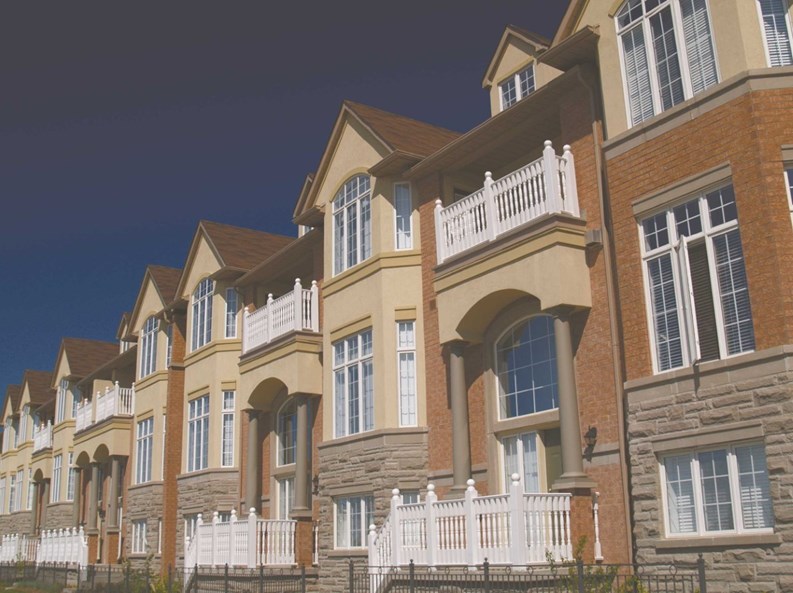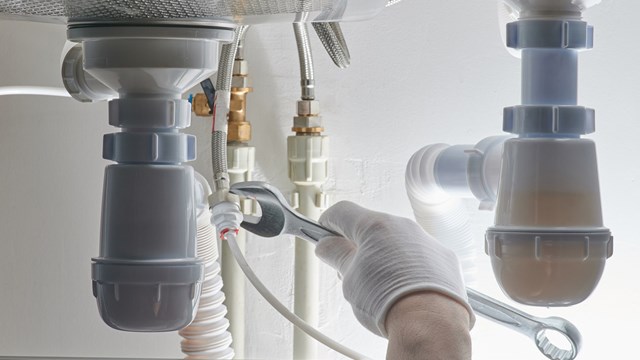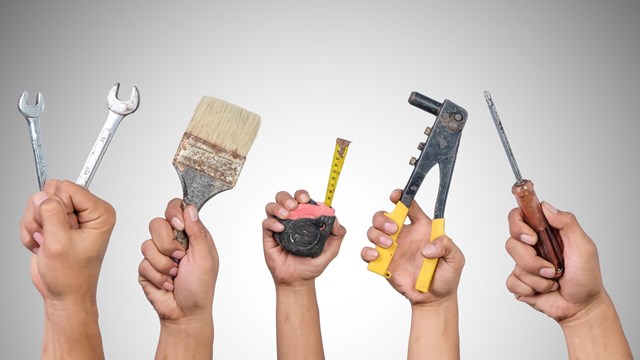We’ve all heard the expression about the importance of “putting your best face forward.” It holds true for the building industry as well—though in that case, “putting your best façade forward” might be more accurate.
All puns aside, the façade of your building is one component of the structure that must be well cared for. Whether the building is old or new, built of stone or wood with vinyl siding, damage to its façade can cause substantial damage to the look and feel of your building. It’s also unintentionally advertising to potential residents that the building isn’t being maintained. Anyone who can see warped, stained siding, discolored brick, or other deterioration on the exterior will rightfully wonder how well the interior of the building is being cared for.
What’s it Made Of?
How a façade is maintained or repaired depends on the material it’s made of. In New Jersey, the most common material on condominiums and townhomes is vinyl siding—especially in the more suburban areas. Less common, particularly in newer developments, is brick and stone. Sometimes buildings combine both higher- and lower-end materials and incorporate both vinyl and stone and/or brick.
According to the Vinyl Siding Institute in Washington D.C., vinyl siding was first introduced to the exterior cladding market in the early 1960s and steadily grew in popularity over the next four decades because of its durability, versatility and ease of maintenance.
“The estimate in our market is that 90 percent of our market is vinyl,” says Mark Gluhosky, regional manager of Kamco Supply Corporation of New Jersey, an exterior maintenance and supply company based in Paterson. “Vinyl is the most predominate exterior surface in the northeast. Typically, the side and the rear of a townhome or condominium building will be vinyl, while the front may have brick, stone or even wood.”
Not only is vinyl the most popular of sidings in the condominium and town home buildings, but the professionals say it’s also the best value of any exterior material.
“Vinyl is far and away the best value of any material,” says Walt Hoyt, director of communications for Certainteed Siding Products Group in Valley Forge, Pennsylvania. “The color is built right in, it comes in panels and it’s relatively easy to install. It‘s highly durable and practically maintenance-free.”
Another material that’s gaining a wider acceptance throughout the region is fiber cement siding. According to R. Russell Fernandes, principal/vice president of Becht Engineering BT, Inc. in Liberty Corner, New Jersey, “Fiber cement siding is manufactured of lightweight concrete with wood and/or fiberglass fibers to add strength. The siding is available pre-painted from the factory, has a wood grain impression on the front surface, and closely resembles wood siding. It tends to be more expensive than vinyl and will require repainting over time.Because it’s more expensive, we often see this material on higher-end homes.”
Brick, stone and metal are also commonly used in both urban and suburban buildings—though both materials are far more expensive than vinyl or fiber cement panels. According to Wilson, brick and stone are, hands down, the most durable exterior siding for a structure. “Installed correctly, there’s no doubt that they handle the weather,” says Wilson. “Of course, they cost appreciably more than their alternatives.”
Signs and Symptoms
Nothing—not even stone—lasts forever, although certain siding materials have lengthy life spans. “The expression in the industry is ‘wood is good, but vinyl is final,’” says Fernandes. “Wood siding available today is generally not as resilient as wood available say, in the 1950’s because wood from the ‘good old days’ was cut out of large trees from old growth forests.
“Today, to preserve old growth forests most wood products are cut from younger trees that are harvested by lumber companies from their own cultivated forests. As a result, the lumber has more grain per inch, which makes the wood less stable and less durable.We have seen 20-year-old wood siding that has failed.”
Fernandes says that most vinyl siding comes with a 40-year warranty with some companies offering “limited lifetime warranties.”
“Fiber cement products probably fall somewhere in the middle of those two extremes. The product is relatively young however, so there is not a lot of experience to make a projection as yet,” he says. “It is important to note that no product will hold up well if it has not been properly installed.”
Just like a weathered face shows signs of aging and deterioration through its wrinkles, a weathered and broken façade shows telltale signs of needing repair too. Cracked mortar, warping, splitting, cracks and leaks are an exterior’s cry for help.
“If you see cracking, or the joints are opening or you see anything that can allow water to penetrate, it needs to be addressed ASAP,” says Steven Z. Tingir, chief specification writer at Rand Engineering & Architecture, PC in New York City.
From the Outside In
Regardless of whether the exterior is constructed with brick, stone, vinyl, fiber cement or wood, the experts agree that the most important part of exterior maintenance starts with the building and installation process.
“It’s far more important that the siding is installed correctly, over a sound exterior building envelope,” says Wilson. “All siding, even stone and brick, will inevitably allow water in behind it. As a result, it’s so important that the outer building envelope is designed and installed to allow trapped water to escape; this is called a `drainage plane.’ It’s a very common misconception that siding will be protected from water intrusion. The damage that occurs from improperly designed and installed drainage planes runs from mold and mildew to rot and even to decreased energy efficiency, leading to increased costs over the life of the building.”
“All siding choices require an under-layer of tar paper or house wrap, along with proper flashings, to prevent water infiltration into the building walls,” says Fernandes. “Windblown rain is one of the most difficult conditions to protect against.Most siding and flashing installations follow the old adage that ‘water flows downhill.’ However, when wind is added into the equation, that adage is proven wrong, because water can in fact be pushed ‘uphill’ and under most siding and flashing systems. The proper installation of the under-layer system will protect against damage from water infiltration.”
If brick moves or steel rusts, most likely it’s because water found its way in and worked its mischief. A square-inch of steel expands to 10 times that volume when it rusts, expanding cracks and causing fissures in masonry. Painting the masonry may also cause moisture problems, as thick layers of paint can trap moisture against surfaces beneath, causing erosion, mold, and other problems.
Who Ya Gonna Call?
Is a crack in your building’s facade something your super can handle, or should you contact a professional? “It depends on the type of damage,” says Tingir. “A small area can probably be done by your maintenance person or a waterproofing contractor. If it’s a widespread problem in a huge complex, you’ll need a qualified contractor to take the job—new bricks might need to be installed or stucco might have to be cut out and new stucco applied.”
If a professional completes the job, be sure to ask about the warranty and if financing plans are usually provided to an HOA or board.
“Most manufacturers offer a warranty, but typically, the products don’t fail,” said Fernandes. “Rather, the system as installed might fail due to faulty installation. In that instance, the manufacturer’s warranty would not cover the failure.In order to ensure that a siding system is properly installed, it is advisable to engage the services of a professional to monitor and inspect the replacement project as it is being installed. In that manner, any improper practices can be identified and corrected immediately, before the improper procedure is allowed to occur elsewhere.”
Consider the Consequences
During lean economic times, buildings may be tempted to save a few bucks by putting off minor repairs, including façade work. Tempting as it may be, the consequences of ignoring a minor problem now, can lead to much bigger and costlier problems down the road. Putting off minor exterior maintenance can lead to serious deterioration and a building that once had a small repair—even on an exterior accessory—now has hundreds of thousands of dollars in damage. So protect your bottom line, by not putting your façade last.
Lisa Iannucci is a freelance writer and a frequent contributor toThe New Jersey Cooperator.







Leave a Comment